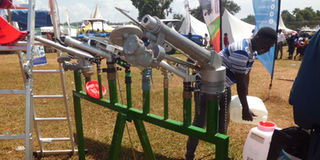How sprinklers will keep your farm green

What you need to know:
The choice of an irrigation method depends on the topography of the land, availability of water, variations in soil types, source of power to pump water, on-farm storage capacity and capital required, writes Lominda Afedraru.
There are various types of irrigation technologies involving different types of tools which farmers can embrace. The commonest being drip irrigation and sprinkler irrigation.
Seeds of Gold got the opportunity to talk to technicians dealing in sprinkler irrigation tools at the Jinja Agriculture Show and below are the tips.
The sprinkler
Herman Mpala, a technician working with RND Power Centre, dealers in irrigation machinery, describes an irrigation sprinkler as a device used to irrigate agricultural crops, lawns and landscapes.
Sprinkler irrigation is the method of applying water in a controlled manner in a way similar to rainfall. The water is distributed through a network that may consist of pumps, valves, pipes, and sprinklers.
It is useful on uneven land where sufficient water is not available and the pipes, have rotating nozzles on top which are joined to the main pipeline at regular intervals of time.
When water is allowed to flow through the main pipe under pressure with the help of a pump, it escapes from the rotating nozzles and gets sprinkled on the crop.
He describes this type of irrigation as a type of pressurised irrigation that consists of applying water to the soil surface using mechanical and hydraulic devices that simulate natural rainfall.
“The devices replenish the water consumed by crops or provide water required for softening the soil to make it workable for the famer during ploughing,” says Mpala.
There are a variety of sprinkler systems ranging from simple hand move to large self-propelled systems.
Affordable types
The different types give different radius of the area to be sprinkled with water and these include nodolin sprinkler, which can sprinkle water up to 100 metre radius of the field depending on the generating engine used, another is RBT which is capable of sprinkling water to a radius of 20 metres.
Others are verosick sprinkler, which is more powerful and can sprinkle up to 1,500 metres radius and Juplex water sprinkler, which is capable of sprinkling water to a radius of 20 metres across the field.
These sprinklers are not applicable in banana plantations which are cumbersome but plantation such as vegetables, legumes such as beans, sweet potatoes and cereals such as rice are good to go with this technology.
For plants that grow tall, the farmer is expected to provide higher stands to allow appropriate sprinkling of water.
The price of the different sprinklers ranges between Shs350,000 and Shs1 million depending on its capacity to spray a given area.
Components
A sprinkler irrigation system consists of a pump unit which takes water from the source and provides pressure for delivery into the pipe system.
The pump must be set to supply water at an adequate pressure so that the water is supplied at a rate and volume adequate to the crop and soil types.In some cases these pipelines are permanently installed on the soil surface or buried below ground.
In other cases they are temporary and can be moved from field to field. The main pipe materials used include asbestos cement, plastic or aluminium alloy.
Advantages
According to Mpala sprinkler irrigation technology can support farmers to adapt to climate change by making more efficient use of their water supply especially during the period of drought.
This can also apply to places where there is limited or irregular water supply for agricultural use.
The sprinkler technology uses less water than irrigation by gravity and provides a more even application of water to the cultivated plot.
Additionally the technology can reduce the risk of crops drying up due to prolonged drought.
During the night the motion of the sprinklers and the application of rain-like water droplets can reduce the stress on crops caused by changes in the temperature.
How to install
Mpala explains that when planning to install a sprinkler irrigation system, information should be obtained regarding the following key factors which include the crop to be cultivated and their water requirements throughout the growing season.
The shape and size of the field. This will determine the range of suitable technologies, investment and labour requirements.
Topography in particular the location and elevation of the water source relative to the field, land slopes and uniformity.
The water source which can be surface water underground water or nonconventional water source such as wells, springs or rivers.
It is important to sensitise farmers on how to use the equipment after installation as well as on maintenance and repair of the system.
Maintenance of the system mainly relates to regular cleaning of the component parts.
Seals on pipes and sprinkler nozzles should be checked to avoid water seepage. During periods when the equipment is not being used, it is recommended to store component parts in a cool, dark place.
Mpala advises farmers to consider selecting sprinklers that send large drops of water close to the ground because they are more water-efficient than sprinklers that spray a fine mist and lose a lot of water through evaporation.
However for plants such as trees, shrubs, perennials and groundcovers drip irrigation is better because little or no water is lost to evaporation as the water is applied at ground level, near plant roots.




